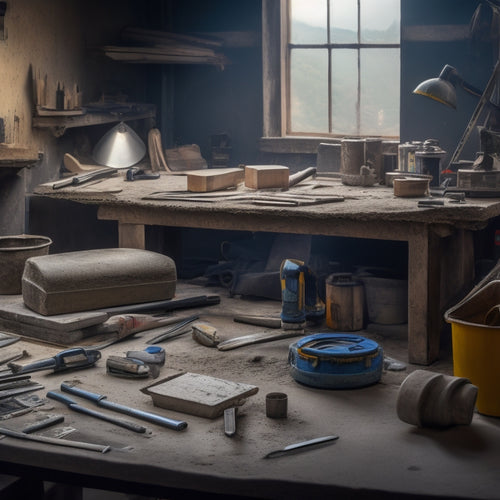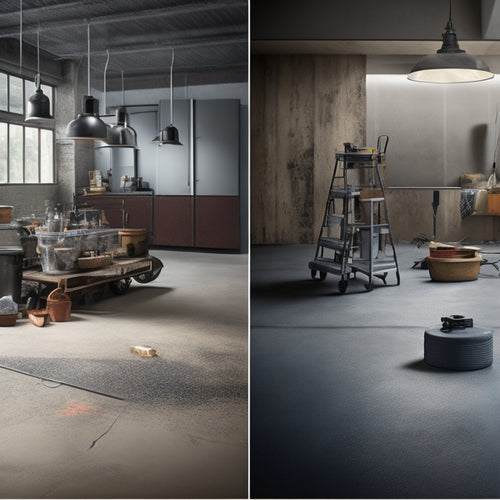
5 Best Tools for Cutting and Shaping Concrete Blocks
Share
When cutting and shaping concrete blocks, you'll need a reliable arsenal of specialized tools to tackle the task efficiently and effectively. Diamond blade circular saws offer precise cuts, while concrete block splitting tools help break down blocks into manageable pieces. Wet cutting core drills provide accurate circular cuts, and handheld concrete grinders smooth surfaces and remove old adhesive. Masonry chiseling hammer sets are also essential for concrete block projects. With these five tools, you'll be well-equipped to tackle your project, and understanding their specific uses and features will take your work to the next level of precision and control.
Key Takeaways
• Diamond blade circular saws provide precise cuts in concrete blocks with continuous rim, segmented, or turbo blades.
• Concrete block splitting tools, like block splitters and hydraulic splitters, break down blocks with controlled force.
• Wet cutting core drills ensure precise, circular cuts with reduced mess and heat buildup, ideal for abrasive materials.
• Handheld concrete grinders remove old adhesive, smooth surfaces, and polish concrete with diamond-coated or carbide-tipped grinding wheels.
• Masonry chiseling hammer sets, with pointed and flat chisel bits, break up old mortar and scrape surfaces with proper grip and stance.
Diamond Blade Circular Saws
You'll get the most precise cuts with a diamond blade circular saw, which utilizes a rotating blade embedded with diamond grit to make clean, accurate cuts through concrete blocks.
When selecting a diamond blade, consider the type of cut you need to make and the concrete block's hardness. There are several diamond blade types, including continuous rim, segmented, and turbo blades, each suited for specific applications. Continuous rim blades are ideal for fine cuts, while segmented blades are better for heavy-duty cutting. Turbo blades offer a balance between the two.
To guarantee circular saw safety, always wear protective gear, including gloves, safety glasses, and a dust mask. Keep your work area clean and well-ventilated to prevent dust buildup and respiratory issues.
Make sure the saw is properly assembled and maintained, and always follow the manufacturer's instructions. When cutting, apply gentle to moderate pressure, and avoid applying too much pressure, which can cause the blade to bind or kickback.
Concrete Block Splitting Tools
When it comes to splitting concrete blocks, a concrete block splitting tool, such as a block splitter or a hydraulic splitter, is an essential device that enables you to break down blocks into smaller, more manageable pieces with controlled force and precision.
These tools are designed to apply consistent pressure, ensuring a clean split without damaging the surrounding material. You'll find that concrete block cutters and splitters are particularly useful when working with large blocks or irregular shapes.
By mastering block splitting techniques, you can achieve precise cuts and reduce waste. Hydraulic splitters, in particular, offer superior force and accuracy, making them ideal for heavy-duty projects.
Whether you're a seasoned pro or a DIY enthusiast, investing in a high-quality concrete block splitting tool will elevate your work and streamline your process.
With the right tool, you'll be able to tackle complex projects with confidence, delivering exceptional results that meet your clients' expectations.
Wet Cutting Core Drills
For tasks that require making precise, circular cuts in concrete blocks, wet cutting core drills offer a high-degree of accuracy and control, especially when working with harder, more abrasive materials. You'll appreciate the reduced mess and heat buildup associated with wet cutting techniques, which also help to prevent damage to the surrounding concrete.
When selecting a wet cutting core drill, consider the following key features:
| Feature | Consideration |
|---|---|
| Motor Power | Higher power for faster cutting, but also increased weight and cost |
| Drill Bit Material | Diamond-coated or tungsten carbide for durability and effectiveness |
| Cooling System | Effective water flow and circulation for ideal performance |
| Ergonomics | Balanced design and comfortable grip for reduced fatigue |
| Maintenance | Ease of core drill maintenance, including bit replacement and cleaning |
Proper core drill maintenance is vital to extend the lifespan of your tool and guarantee ideal performance. Regularly clean the drill and bits, and replace worn-out components to maintain accuracy and efficiency.
Handheld Concrete Grinders
Handheld concrete grinders excel at removing old adhesive, smoothing out rough surfaces, and polishing concrete blocks to a high shine. As a professional, you need a reliable tool that can get the job done efficiently. That's where portable concrete grinders come in. These compact powerhouses are designed to tackle tough concrete surfaces, making them an essential tool for any concrete worker.
When choosing a handheld concrete grinder, safety features should be top of mind. Look for grinders with dust collection systems, which reduce the risk of respiratory problems and keep the work area clean. You'll also want to evaluate grinders with adjustable handles, which provide comfort and control during extended use.
Additionally, assess the type of grinding wheel you need. Diamond-coated wheels are ideal for aggressive grinding, while carbide-tipped wheels are better suited for polishing and smoothing.
With the right handheld concrete grinder and accessories, you'll be able to tackle even the toughest concrete projects with ease and confidence. By investing in a high-quality grinder, you'll be able to deliver professional results and exceed your clients' expectations.
Masonry Chiseling Hammer Sets
Your go-to masonry chiseling hammer set should be equipped with a variety of chisel bits and handles, allowing you to tackle concrete block projects that require precise removal of old mortar, demolition of existing structures, or refinement of rough edges.
When selecting a hammer set, consider the type of chiseling you'll be doing most often. For example, a pointed chisel is ideal for breaking up old mortar, while a flat chisel is better suited for scraping and smoothing surfaces.
To master masonry chiseling techniques, practice proper grip and stance, keeping your dominant hand at the end of the handle and your other hand near the hammer head. Always wear safety goggles and a dust mask to protect yourself from flying debris.
Remember to maintain a firm, controlled swing, and avoid hitting the chisel at an angle, which can cause it to slip and lose control. Additionally, follow essential hammer safety tips, such as inspecting the hammer and chisel before use and storing them properly when not in use.
With the right tools and techniques, you'll be able to tackle even the most demanding concrete block projects with confidence.
Frequently Asked Questions
Can I Use a Regular Saw to Cut Concrete Blocks?
You're wondering if a regular saw can cut concrete blocks? The short answer is, it's not recommended.
Regular saws, like circular or reciprocating saws, aren't designed for cutting concrete and can lead to damage or wear.
Instead, consider using saws specifically designed for concrete cutting, such as a diamond blade saw or a concrete saw.
These saws, along with proper cutting techniques, will help you achieve clean cuts and extend the life of your tool.
How Do I Avoid Damaging Surrounding Structures During Demolition?
As you stand amidst the dust and debris, envision the surrounding structures as fragile puzzle pieces.
To avoid damaging them during demolition, you'll need to employ precise techniques.
Start by evaluating the structural stability of adjacent buildings or walls.
Then, develop a strategic demolition plan, using hand tools or machinery with calculated precision.
Employ dust-suppressing measures and contain the work zone to prevent collateral damage.
Are There Any Specific Safety Precautions for Concrete Cutting?
When cutting concrete, you must prioritize your safety above all else.
You'll need personal protective equipment like gloves, safety glasses, and a dust mask to prevent injury.
Implement dust control measures, such as wet cutting or using a vacuum with a HEPA filter, to minimize airborne silica particles.
Ascertain good ventilation and restrict access to the work area to prevent bystander exposure.
Can I Reuse Concrete Blocks After They've Been Cut?
When you're left with cut concrete blocks, you're likely wondering if you can reuse them. The good news is that, with proper cutting techniques, you can.
Reusing concrete blocks offers several benefits, including reduced waste and cost savings.
However, it's essential to inspect the blocks for damage and guarantee they're still structurally sound. If they're in good condition, you can reuse them, but be sure to clean and prepare them properly for their next use.
What Is the Ideal Temperature for Cutting and Shaping Concrete?
As you step into the construction zone, the scorching sun beats down, and you're faced with the vital question: what's the ideal temperature for cutting and shaping concrete?
Imagine the concrete as a delicate canvas, sensitive to temperature effects. Under best conditions, you'll want to operate between 40°F and 90°F (4°C and 32°C).
This range guarantees the concrete remains stable, allowing for precise cuts and shapes, and ultimately, a stronger final product that serves its purpose with integrity.
Conclusion
You've got the right tools for the job, and now it's time to break new ground.
Remember, when it comes to cutting and shaping concrete blocks, having the right tool for the task can make all the difference.
Don't be stuck between a rock and a hard place - with these high-quality tools, you'll be able to tackle any concrete project that comes your way.
So, get ready to take your skills to the next level and make a concrete impression!
Related Posts
-

3 Best Hand Tools for DIY Concrete Construction
When tackling a DIY concrete construction project, you'll need three essential hand tools to achieve a professional-l...
-

Why You Need Affordable Concrete Wall Construction Tools
You need affordable concrete wall construction tools to guarantee a profitable project, as the cost of equipment can ...
-

Top Tools for Revamping Old Concrete Floors
You'll need a range of tools to revamp your old concrete floor, starting with epoxy, acrylic, or polyurethane paint, ...


